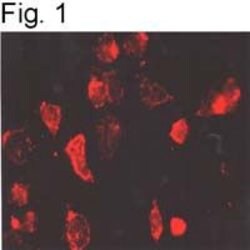Learn More
Invitrogen™ beta-1 Adrenergic Receptor Polyclonal Antibody


Rabbit Polyclonal Antibody
Supplier: Invitrogen™ PA1049
Description
PA1-049 detects beta-1 adrenergic receptor (B1AR) from , human, mouse, non-human primate, and rat tissues. PA1-049 has been successfully used in Western blot and immunofluorescence procedures. By Western blot, this antibody detects an ~50.5 kDa band representing B1AR in mouse kidney membrane preparation. Immunofluorescence staining of B1AR in mouse kidney distal tubule with PA1-049 yields a pattern consistent with plasma membrane staining. The PA1-049 immunogen is a synthetic peptide corresponding to residues H(394) G D R P R A S G C L A R A G(408) of mouse B1AR. This sequence is completely conserved between mouse and rat B1AR.
Adrenergic receptors (ARs) are members of the 7-transmembrane domain G-protein-coupled receptor superfamily that bind the endogenous catecholamines epinephrine and norepinephrine. Pharmacological, structural, and molecular cloning data indicate significant heterogeneity within this receptor family. Nine receptor subtypes have been identified thus far including three alpha-1 AR subtypes (1A/D, 1B, and 1C), three alpha-2 ARs (2A, 2B, and 2C), and three beta AR subtypes (1, 2, and 3). ARs participate in either the onset or maintenance of several disease states including hypertension, cardiac dysfunction (congestive heart failure, ischemia, arrhythmias), diabetes, glaucoma, depression, and impotence. BARs participate in diverse processes including development, behavior, cardiac function, smooth muscle tone, and metabolism. In gene-knockout experiments, the majority of mice that lack the B1AR gene die prenatally and those that do survive until adulthood display abnormal cardiac function. Other studies have shown that the direct regulation of cardiac B1AR density by thyroid hormones occurs at the transcriptional level and is modulated by the catecholamine sensitive-adenylyl cyclase system. Evidence for the effects of cAMP on B1AR regulation has come from a study of members of the cAMP response element (CRE) modulator (CREM) family of transcription factors in transformed cell lines.
Specifications
| beta-1 Adrenergic Receptor | |
| Polyclonal | |
| Unconjugated | |
| ADRB1 | |
| Adrb1; Adrb-1; ADRB1R; adrenergic receptor, beta 1; adrenergic, beta-1-, receptor; adrenoceptor beta 1; B1AR; beta 1-adrenergic receptor beta 1-AR; beta 1-AR; beta-1 adrenergic receptor; Beta-1 adrenoceptor; beta-1 adrenoreceptor; BETA1AR; beta-AR; cardiac beta adrenergic receptor; RATB1AR; RHR | |
| Rabbit | |
| 100 μL | |
| Primary | |
| Human, Mouse, Rat, Monkey | |
| Antibody | |
| IgG |
| Immunohistochemistry, Western Blot, Immunocytochemistry | |
| Conc. Not Determined | |
| Whole serum with 0.05% sodium azide | |
| P08588, P18090, P34971 | |
| ADRB1 | |
| Synthetic peptide corresponding to residues H(394) G D R P R A S G C L A R A G(408) of mouse B1AR. | |
| RUO | |
| 11554, 153, 24925 | |
| -20°C, Avoid Freeze/Thaw Cycles | |
| Liquid |
Safety and Handling
Your input is important to us. Please complete this form to provide feedback related to the content on this product.



